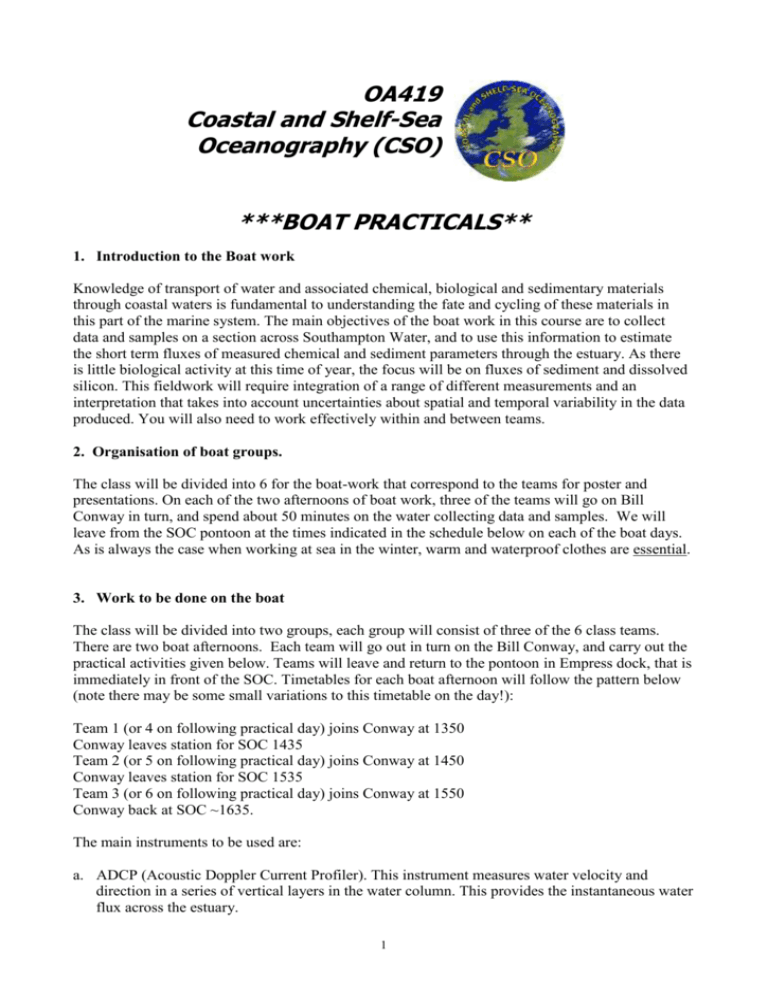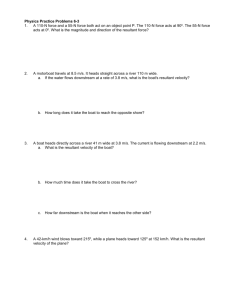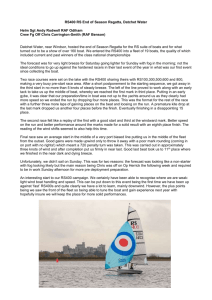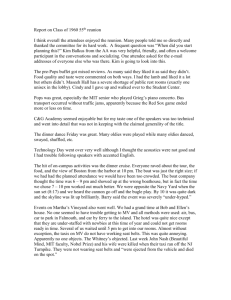OA419
advertisement

OA419 Coastal and Shelf-Sea Oceanography (CSO) ***BOAT PRACTICALS** 1. Introduction to the Boat work Knowledge of transport of water and associated chemical, biological and sedimentary materials through coastal waters is fundamental to understanding the fate and cycling of these materials in this part of the marine system. The main objectives of the boat work in this course are to collect data and samples on a section across Southampton Water, and to use this information to estimate the short term fluxes of measured chemical and sediment parameters through the estuary. As there is little biological activity at this time of year, the focus will be on fluxes of sediment and dissolved silicon. This fieldwork will require integration of a range of different measurements and an interpretation that takes into account uncertainties about spatial and temporal variability in the data produced. You will also need to work effectively within and between teams. 2. Organisation of boat groups. The class will be divided into 6 for the boat-work that correspond to the teams for poster and presentations. On each of the two afternoons of boat work, three of the teams will go on Bill Conway in turn, and spend about 50 minutes on the water collecting data and samples. We will leave from the SOC pontoon at the times indicated in the schedule below on each of the boat days. As is always the case when working at sea in the winter, warm and waterproof clothes are essential. 3. Work to be done on the boat The class will be divided into two groups, each group will consist of three of the 6 class teams. There are two boat afternoons. Each team will go out in turn on the Bill Conway, and carry out the practical activities given below. Teams will leave and return to the pontoon in Empress dock, that is immediately in front of the SOC. Timetables for each boat afternoon will follow the pattern below (note there may be some small variations to this timetable on the day!): Team 1 (or 4 on following practical day) joins Conway at 1350 Conway leaves station for SOC 1435 Team 2 (or 5 on following practical day) joins Conway at 1450 Conway leaves station for SOC 1535 Team 3 (or 6 on following practical day) joins Conway at 1550 Conway back at SOC ~1635. The main instruments to be used are: a. ADCP (Acoustic Doppler Current Profiler). This instrument measures water velocity and direction in a series of vertical layers in the water column. This provides the instantaneous water flux across the estuary. 1 b. CTD (conductivity, temperature, depth instrument package) and associated rosette (that holds a series of water sampling bottles that can be closed from the boat on demand). The water bottles will allow collection of water samples for collection of samples for dissolved silicon analysis and suspended particulate matter (SPM). These instruments will be introduced in the lecture prior to the boat afternoon. For the boat work on the estuary, a first transect across the estuary will be done to test the ADCP instrument and collect velocity data, and the CTD-rosette system will be used on either side of Southampton Water, and at a central location. Data on the salinity, temperature and transmission structure of the water column, and water samples from the sampling bottles on the rosette, will be collected. A return leg along the same track will be done to collect a definitive water velocity data set When all groups have been on the water in an afternoon there will be data and samples available to estimate the fluxes of dissolved silicon and SPM, at the time the work was done. 4. Work to be done in the laboratory The three teams on the boat on a particular afternoon will split into 2 equal sets of about 11-12 for the laboratory practical the following day. For the first part of the day one set will work on the physical data and the other will work on the chemical (Si) measurements and SPM determination. Half way through the afternoon (about 1515h) these sets will change over to ensure each set understands the work up of the data or samples. Details on each procedure will be given at the respective practical. The physical group will be based in the node room 084/02, and the chemical/SPM measurements will be done in the chemistry teaching lab184/05. Note that files of data will be used by other groups (see below) and therefore all data sets should be named in an unambiguous way and accompanied by a text file describing how and when the data was obtained and by whom. 5. Use of data and report preparation a. If you have information on the water flux through the estuary (from ADCP) at a particular time and data on concentration of e.g. Si or SPM, a simple product of the two will give a mass flux of the material of interest. However this is a crude approach and potentially very inaccurate. In your report you will need to take a critical view of the available information and the calculations you carry out. For example is the concentration the same across the estuary? How does it vary where you do not have data and how do you interpolate? Were the measurements of SPM and water flux synoptic? If not how do you improve your estimates? For example you could use your data on SPM from the water bottles to calibrate the transmissometer on the CTD system and thus have continuous SPM data through the water column. b. The three groups work on a particular afternoon will be collecting data over a three-hour period of time. How do variations in fluxes relate to tidal state and other meteorological forcing? You will need to access data from other groups to assess this issue and so it is expected data will be freely available between the groups. c. Format of the reports. Whilst much work and discussion will be done in groups the final reports will be done by individuals. These will follow the general format used in earlier boat practical reports, and will typically be between 4 and 6 pages in length. If detailed instructions exist for, e.g., a chemical analysis there is no need to rewrite this material- an attached photocopy or good appropriate reference is fine. If there are queries about the report or any other aspect of the practical see Peter Statham or Jonathan Sharples. 2







